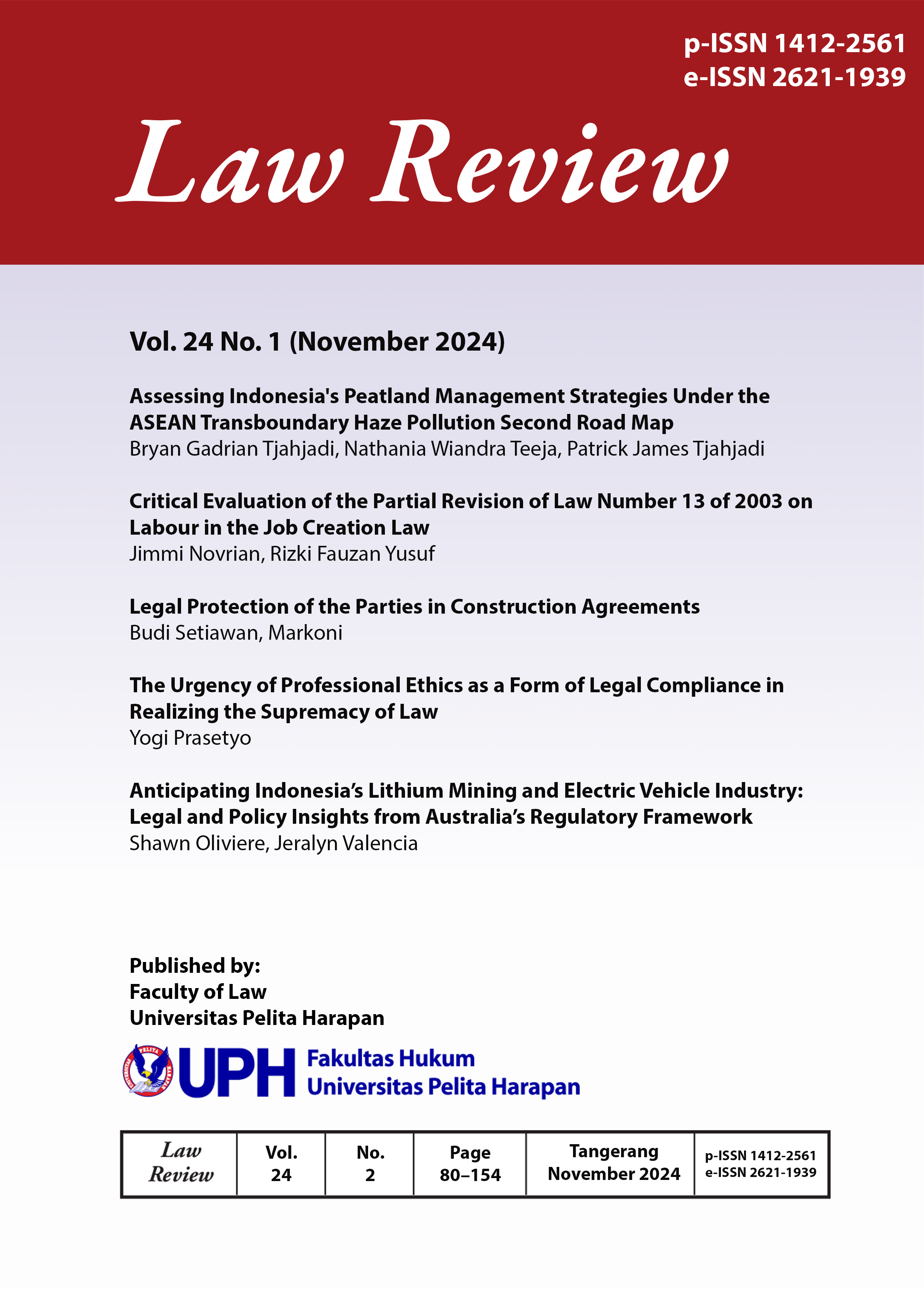Assessing Indonesia's Peatland Management Strategies Under the ASEAN Transboundary Haze Pollution Second Road Map
DOI:
https://doi.org/10.19166/lr.v24i2.9726Kata Kunci:
Peatland Management, Transboundary Haze Pollution, Environmental GovernanceAbstrak
Peatland ecosystems in Southeast Asia are vital carbon sinks and biodiversity reserves, yet they face persistent threats from unsustainable land-use practices, particularly fire-based land clearing. Indonesia, which holds a significant share of the region’s tropical peatlands, remains a key actor in addressing the environmental and transboundary haze crises stemming from peatland degradation. As a member of ASEAN, Indonesia is bound by regional commitments, including the ASEAN Agreement on Transboundary Haze Pollution and the ASEAN Second Haze-Free Roadmap (2023–2030), which promotes sustainable peatland management through strategies such as the ASEAN Peatland Management Strategy (APMS). This paper aims to critically assess Indonesia’s peatland management strategies in light of these regional obligations. It evaluates the implementation and enforcement of the Zero Burn Policy, the current state of peatland rehabilitation and preservation efforts, the institutional and legal roles of the Indonesian government, and comparative insights drawn from other ASEAN member states. This research uses a combination normative and empirical juridical research methodology, integrating doctrinal legal analysis with contextual evaluation of implementation practices. Despite regulatory advancements and institutional initiatives, Indonesia continues to face significant challenges, including weak enforcement, persistent land burning, and fragmented governance. The paper concludes that achieving sustainable peatland management and fulfilling ASEAN commitments requires stronger inter-agency coordination, enhanced legal clarity, and deeper regional collaboration rooted in shared environmental governance principles.
Referensi
Laws and Regulations
Republic of Indonesia Law Number 41 of 1999 on Forestry.
Republic of Indonesia Law Number 32 of 2009 on Environmental Protection and Management.
Republic of Indonesia Law Number 34 of 2014 on Plantation.
Republic of Indonesia Government Regulation Number 57 of 2016 on the Amendment to Government Regulation Number 71 of 2014 on the Protection and Management of Peatland Ecosystems.
Books
ASEAN Secretariat. ASEAN Peatland Management Strategy (2023–2030). Jakarta: ASEAN Secretariat, 2023. https://asean.org/wp-content/uploads/2024/04/APMS-2-Apr-Web.pdf.
Purnomo, H., and D. Puspitaloka. Pembelajaran Pencegahan Kebakaran dan Restorasi Gambut Berbasis Masyarakat. Bogor: CIFOR, 2020.
Journal Articles
Mulyono, A. T., and R. K. Karo. “Questioning a Fair Settlement as the Legal Resolution of Global Interests.” IOP Conference Series: Earth and Environmental Science 1270, no. 1 (2023): 012025. https://doi.org/10.1088/1755-1315/1270/1/012025.
Sakti, Demayu Mega, Sintya Yuni Permatasari, and Dyah Fitri Kurniasari. “Status of the Principle Paying Principle in the Indonesian Legal System.” International Journal of Advanced Multidisciplinary Research and Studies 3, no. 4 (2023). https://www.multiresearchjournal.com/arclist/list-2023.3.4/id-1411.
Syahza, Almasdi, Sri Astuti, Suarman, and Brilliant Asmit. “Efforts to Prevent Peatland Fires through Implementing Local Community Education.” Asian Education and Development Studies 13, no. 5 (2024): 550–67. https://doi.org/10.1108/AEDS-06-2024-0132.
International Treaties
ASEAN Agreement on Transboundary Haze Pollution.
News Articles
Sandra. “Apa Itu Polluter Pays Principle.” Pajakku, August 13, 2021. https://artikel.pajakku.com/apa-itu-polluter-pays-principle/.
Vong Sok, and Swetha Peteru. “As Southeast Asia’s Haze Dissipates, Managing Peatlands Is More Urgent than Ever - CIFOR-ICRAF Forests News.” CIFOR Forests News, November 11, 2024. https://forestsnews.cifor.org/90047/as-southeast-asias-haze-dissipates-managing-peatlands-is-more-urgent-than-ever?fnl=.
Wipatayotin, Apinya. “ASEAN Targets Haze-free Peatlands by 2030.” Bangkok Post, August 18, 2024. https://www.bangkokpost.com/thailand/general/2849022/asean-targets-haze-free-peatlands-by-2030.
World Resources Institute. “Indonesia’s Fire Outbreaks Producing More Daily Emissions than Entire US Economy.” World Resources Institute, October 16, 2015. https://wri-indonesia.org/en/insights/indonesias-fire-outbreaks-producing-more-daily-emissions-entire-us-economy.
Website Contents
Ministry of Environment and Forestry, Republic of Indonesia. “Restorasi dan Perlindungan Gambut.” Last modified April 4, 2018. http://pojokiklim.menlhk.go.id/read/restorasi-dan-perlindungan-gambut.
Ministry of Natural Resources and Environment Malaysia. National Action Plan for Peatlands. Putrajaya: Ministry of Natural Resources and Environment Malaysia, 2011. Accessed April 25, 2025. https://www.nres.gov.my/ms-my/pustakamedia/Penerbitan/National%20Action%20Plan%20for%20Peatlands.pdf.
Nancy Harris, Susan Minnemeyer, Fred Stolle, and Octavia Aris Payne. “Indonesia’s Fire Outbreaks Producing More Daily Emissions than Entire US Economy.” WRI Indonesia, October 16, 2015. https://wri-indonesia.org/en/insights/indonesias-fire-outbreaks-producing-more-daily-emissions-entire-us-economy?__cf_chl_rt_tk=p9wGCVzzFU2_pN7YWRuaDiJb0hxHrNMinwvxmUV31CM-1758794822-1.0.1.1-LZRIjbMQOl5X8VIDM1MARqkrERR0vz8ztPeKOSZNpJI.
Pantau Gambut. “Peatland Restoration Steps.” Accessed April 21, 2025. https://en.pantaugambut.id/peat-101/peatland-restoration-steps.
PT Sinar Mas Agro Resources and Technology Tbk (PT SMART Tbk). “Fire & Haze Management.” Accessed April 20, 2025. https://www.smart-tbk.com/en/berkelanjutan/pengelolaan-pemantauan-konservasi/penanganan-kebakaran-kabut-asap/.
PT Sinar Mas Agro Resources and Technology Tbk. “Peat Restoration: Rebuilding Nature, One Step at a Time.” Accessed April 20, 2025. https://www.smart-tbk.com/en/cara-kerja-restorasi-gambut-rehabilitasi-gambut/.
S Sudarno, Nano, and Akhmad Widjaya. Studi Konsep Pengembangan Desa Mandiri Peduli Gambut (DMPG) Provinsi Kalimantan Timur. PROPEAT, in cooperation with GIZ and the Ministry of Environment and Forestry of the Republic of Indonesia, May 2022. https://pkgppkl.menlhk.go.id/v0/wp-content/uploads/2023/08/02-Studi-Pengembangan-Desa-Mandiri-Peduli-Gambut-Kalimantan-Timur.pdf.
Testbook. “Polluter Pays Principle – Background, Importance, Landmark Judgements, and More!” Last modified January 17, 2024. https://testbook.com/ias-preparation/polluters-pay.
Winarno, B., D. Rohadi, T. Herawati, M. Rahmat, and E. Suwarno. “Out of Fire Disaster: Dynamics of Livelihood Strategies of Rural Community on Peatland Use and Management.” IOP Conference Series: Earth and Environmental Science 487 (2020): 012008.https://www.cifor-icraf.org/publications/pdf_files/articles/ARohadi2001.pdf.
Unduhan
Diterbitkan
Cara Mengutip
Terbitan
Bagian
Lisensi
Hak Cipta (c) 2025 Bryan Gadrian Tjahjadi, Nathania Wiandra Teeja, Patrick James Tjahjadi

Artikel ini berlisensi Creative Commons Attribution-NonCommercial 4.0 International License.
Authors who publish with this journal agree to the following terms:
1) Authors retain copyright and grant the journal right of first publication with the work simultaneously licensed under a Creative Commons Attribution License (CC-BY-SA 4.0) that allows others to share the work with an acknowledgement of the work's authorship and initial publication in this journal.
2) Authors are able to enter into separate, additional contractual arrangements for the non-exclusive distribution of the journal's published version of the work (e.g., post it to an institutional repository or publish it in a book), with an acknowledgement of its initial publication in this journal.
3) Authors are permitted and encouraged to post their work online (e.g., in institutional repositories or on their website). The final published PDF should be used and bibliographic details that credit the publication in this journal should be included.





